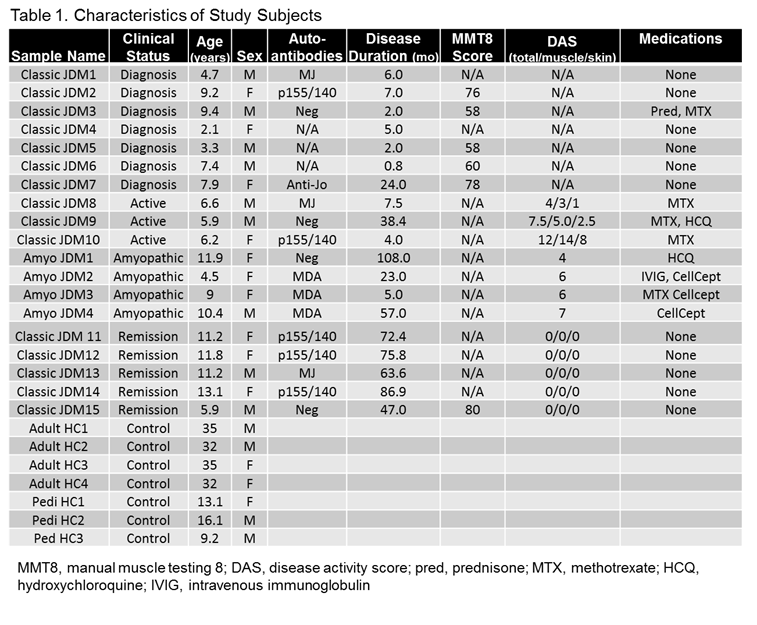Session Information
Session Type: Abstract Submissions
Session Time: 4:45PM-5:15PM
Background/Purpose: In adult dermatomyositis (DM), clonal populations of T and B cells with shared variable (V) gene usage have been identified in affected muscle, suggesting aberrant lymphocyte responses to a common antigen. Using next generation sequencing (NGS), we aimed to determine if these previously identified repertoire abnormalities in the muscle of adult DM patients could be detected in the peripheral blood (PB) of children with juvenile DM (JDM).
Methods: PB was obtained from JDM patients with skin and muscle disease (classic JDM) at diagnosis, during active disease, and at remission when patients were off medication. Amyopathic patients and healthy controls were also studied. CD8+ T and CD19+ B cells were isolated from PB mononuclear cells (PBMC) by magnetic beads. The remaining lymphocyte populations were isolated by fluorescence activated cell sorting: CD4/CD8 naïve (N) T cells (C3+CD4+/CD8+CD45RA+CCR7+), CD4/ CD8 memory (M) T cells (CD3+CD4+/CD8+CD45RA–), Treg cells (CD3+CD4+CD25+CD127lo), Teff cells (CD3+CD4+CD25–), Naïve B cells (CD19+IgD+CD27–), and CD21lo B cells (CD19+CD21loCD38lo). The TCR β (TRB) and BCR heavy (IgH) chains were amplified by multiplex PCR with a standard quantity of genomic DNA serving as the template (ImmunoSEQTM). Illumina HiSeq platform was used for sequencing. Productive sequences were analyzed using the ImmunoSEQ set of online tools. Mann Whitney and 1-way ANOVA tests were used to compare the clonality index, Shannon entropy, and clone sharing in study groups. 2-way ANOVA with Bonferroni correction was used to compare TCRVβ family usage.
Results: Clinical characteristics of the patients are in Table 1. CD21lo B cells, a population of B cells associated with autoimmunity, were more clonal in classic JDM patients with active disease compared to those in remission (p=0.03). Similarly, the Treg repertoire was significantly more clonal in classic JDM patients with active disease than JDM patients in remission (p<0.0001) and amyopathic patients (p=0.002). CD19, CD19N, CD8, CD4/8 N/M, and Teff cells were polyclonal and diverse in all JDM patient groups. In Treg and Teff subsets, TCRVβ families 7, 10, and 28 were used more and Vβ families 3, 5, and 19 were used less in classic JDM patients with active disease compared to controls (p<0.0001for Treg and Teffs). Inter-individual sharing of Teff clonotypes was observed in JDM patients with active disease compared to controls (p<0.001).
Conclusion: Clonal expansions in CD21lo B and Treg cells noted in JDM patients with active disease resolved upon remission. Skewed TCRVβ family usage was observed in active JDM patients with increased usage of Vβ7, a Vβ family that has been linked with other autoimmune conditions. Inter-individual sharing of Teff clonotypes was also observed. Our pilot results suggest that lymphocyte repertoire abnormalities may contribute to disease pathogenesis in JDM and can be detected in PB by NGS.
To cite this abstract in AMA style:
Hoyt K, Anderson E, Curran ML, Fuhlbrigge R, Notarangelo L, Pachman LM, Kim S, Henderson L. The Lymphocyte Repertoire in Juvenile Dermatomyositis [abstract]. Arthritis Rheumatol. 2017; 69 (suppl 4). https://acrabstracts.org/abstract/the-lymphocyte-repertoire-in-juvenile-dermatomyositis-2/. Accessed .« Back to 2017 Pediatric Rheumatology Symposium
ACR Meeting Abstracts - https://acrabstracts.org/abstract/the-lymphocyte-repertoire-in-juvenile-dermatomyositis-2/

